Eukaryotes Study guides, Class notes & Summaries
Looking for the best study guides, study notes and summaries about Eukaryotes? On this page you'll find 4154 study documents about Eukaryotes.
Page 2 out of 4.154 results
Sort by
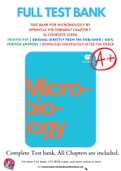
-
Test Bank For Microbiology by OpenStax 978-1938168147 Chapter 1-26 Complete Guide.
- Exam (elaborations) • 446 pages • 2022
-
- $34.53
- 11x sold
- + learn more
Test Bank For Microbiology by OpenStax 978-7 Chapter 1: An Invisible World Chapter 2: How We See the Invisible World Chapter 3: The Cell Chapter 4: Prokaryotic Diversity Chapter 5: The Eukaryotes of Microbiology Chapter 6: Acellular Pathogens Chapter 7: Microbial Biochemistry Chapter 8: Microbial Metabolism Chapter 9: Microbial Growth Chapter 10: Biochemistry of the Genome Chapter 11: Mechanisms of Microbial Genetics Chapter 12: Modern Applications of Microbia...
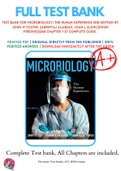
-
Test Bank For Microbiology: The Human Experience 2nd Edition By John W Foster, Zarrintaj Aliabadi, Joan L Slonczewski 9780393533248 Chapter 1-27 Complete Guide .
- Exam (elaborations) • 427 pages • 2023
-
- $25.47
- 3x sold
- + learn more
Test Bank For Microbiology: The Human Experience 2nd Edition By John W Foster, Zarrintaj Aliabadi, Joan L Slonczewski 3248, 7 . 3231, 9 1: Microbes Shape Our History 2: Basic Concepts of Infectious Disease 3: Observing Microbes 4: Living Chemistry: From Atoms to Cells 5: Cell Biology of Bacteria and Eukaryotes 6: Bacterial Growth, Nutrition, and Differentiation 7: Bacterial Metabolism 8: Bacterial Genetics and Biotechnology 9: Bacterial Genomes and Evolution 10: Bac...

-
TEST BANK for Concepts of Genetics, 12th edition. William S. Klug, Michael R. Cummings, Charlotte A. Spencer, Michael A. Palladino, Darrell Killian. All 26 Chapters in 341 Pages
- Exam (elaborations) • 341 pages • 2022
-
- $33.12
- 7x sold
- + learn more
Chapter 1 Introduction to Genetics Page : 13 Chapter 2 Mitosis and Meiosis Page : 29 Chapter 3 Mendelian Genetics Page : 47 Chapter 4 Extensions of Mendelian Genetics Page : 67 Chapter 5 Sex Determination and Sex Chromosomes Page : 81 Chapter 6 Chromosomal Mutations: Variation in Number and Arrangement Page : 95 Chapter 7 Chromosome Mapping in Eukaryotes Page : 110 Chapter 8 Genetic Analysis and Mapping in Bacteria and Bacteriophages Page : 124 Chapter 9 Extranuclear Inhe...
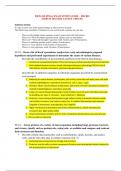
-
BIOS 242 FINAL EXAM STUDY GUIDE – MICRO MARCH 2023-2024 LATEST UPDATE
- Exam (elaborations) • 17 pages • 2023
-
Available in package deal
-
- $9.99
- 2x sold
- + learn more
BIOS 242 FINAL EXAM STUDY GUIDE – MICRO MARCH LATEST UPDATE INSTRUCTIONS: It’s time to show your skills and knowledge of what you have learned! This Final Exam contributes 230 points to your overall grade, so please do your best. • There are 60 multiple choice questions worth 3 points each (180 total points). • There are 5 Fill in the blanks question worth 3 points each (15 total points). • There are 5 “Select all that apply” question worth 3 points each (15 total points). ...
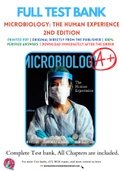
-
Test Bank for Microbiology: The Human Experience 2nd Edition By John W. Foster; Zarrintaj Aliabadi; Joan L. Slonczewski Chapter 1-27 Complete Guide A+
- Exam (elaborations) • 428 pages • 2022
-
- $25.05
- 7x sold
- + learn more
Test Bank for Microbiology: The Human Experience 2nd Edition By John W. Foster; Zarrintaj Aliabadi; Joan L. Slonczewski Chapter 1-27 Complete Guide A+ 3248, 7 1: Microbes Shape Our History 2: Basic Concepts of Infectious Disease 3: Observing Microbes 4: Living Chemistry: From Atoms to Cells 5: Cell Biology of Bacteria and Eukaryotes 6: Bacterial Growth, Nutrition, and Differentiation 7: Bacterial Metabolism 8: Bacterial Genetics and Biotechnology 9: Bacterial Genome...
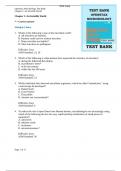
-
Test Bank For Microbiology by OpenStax 978-1938168147 Chapter 1-26 Complete Guide.
- Exam (elaborations) • 443 pages • 2023
-
- $13.99
- 2x sold
- + learn more
Test Bank For Microbiology by OpenStax 978-7 Chapter 1-26 Complete Guide. Test Bank For Microbiology by OpenStax 978-7 Chapter 1: An Invisible World Chapter 2: How We See the Invisible World Chapter 3: The Cell Chapter 4: Prokaryotic Diversity Chapter 5: The Eukaryotes of Microbiology Chapter 6: Acellular Pathogens Chapter 7: Microbial Biochemistry Chapter 8: Microbial Metabolism Chapter 9: Microbial Growth Chapter 10: Biochemistry of the Genome Chapter 11: Mechanisms of Microbial Genetics Chapt...
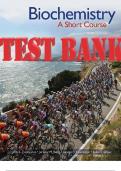
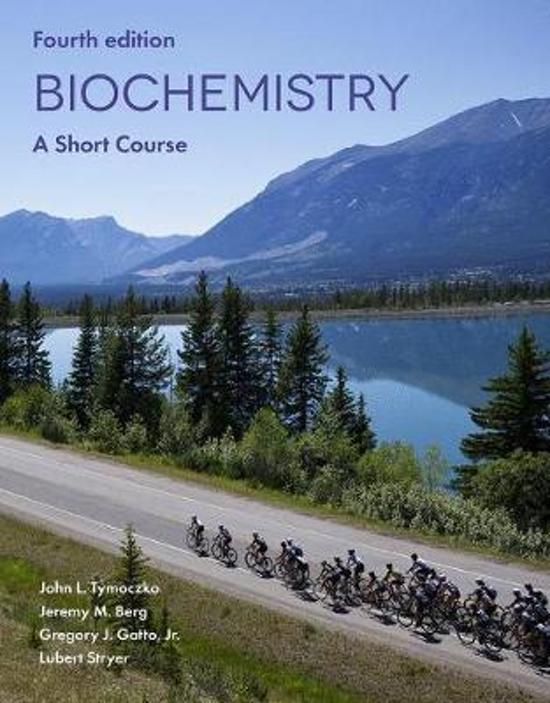
-
TEST BANK for Biochemistry: A Short Course, 4th Edition, John Tymoczko, Jeremy Berg, Gregory Gatto, Lubert Stryer. ISBN: 9781319342883, ISBN: 9781319234379. (Complete 41 Chapters)
- Exam (elaborations) • 452 pages • 2023
-
- $33.12
- 1x sold
- + learn more
TEST BANK for Biochemistry: A Short Course, 4th Edition, John Tymoczko, Jeremy Berg, Gregory Gatto, Lubert Stryer. ISBN: 9781319342883, ISBN: 9781319234379. TABLE OF CONTENTS_ Part I The Molecular D esign of Life SECTION 1 Biochemistry Helps Us to Understand Our World Chapter 1 Biochemistry and the Unity of Life Chapter 2 Water, Weak Bonds, and the Generation of Order Out of Chaos SECTION 2 Protein Composition and Structure Chapter 3 Amino Acids Chapter 4 Protein Three-Dimensional Structure Chap...

-
OpenStax Microbiology Test Bank Chapter 5: The Eukaryotes of Microbiology
- Exam (elaborations) • 15 pages • 2023
-
Available in package deal
-
- $8.99
- + learn more
OpenStax Microbiology Test Bank Chapter 5: The Eukaryotes of Microbiology/OpenStax Microbiology Test Bank Chapter 5: The Eukaryotes of Microbiology
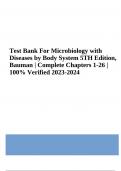
-
Test Bank For Microbiology with Diseases by Body System 5TH Edition, Bauman | Complete Chapters 1-26 | 100% Verified 2023-2024
- Exam (elaborations) • 481 pages • 2023
-
- $35.49
- 2x sold
- + learn more
Test Bank For Microbiology with Diseases by Body System 5TH Edition, Bauman | Complete Chapters 1-26 | 100% Verified 2023-2024. Chapter 1 A Brief History of Microbiology 2 Chapter 2 The Chemistry of Microbiology 19 Chapter 3 Cell Structure and Function 38 Chapter 4 Microscopy, Staining, and Classification 60 Chapter 5 Microbial Metabolism 80 Chapter 6 Microbial Nutrition and Growth 99 Chapter 7 Microbial Genetics 118 Chapter 8 Recombinant DNA Technology 137 Chapter 9 Controlling Microbia...
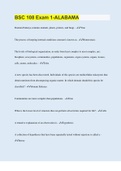
-
BSC 108 Exam 1-ALABAMA | 50 Questions with 100% Correct Answers | Updated 2023
- Exam (elaborations) • 7 pages • 2023
-
- $7.99
- 4x sold
- + learn more
Domain Eukarya contains animals, plants, protists, and fungi. - True The process of keeping internal conditions constant is known as - Homeostasis The levels of biological organization, in order from least complex to most complex, are: biosphere, ecosystems, communities, populations, organisms, organ systems, organs, tissues, cells, atoms, molecules. - False A new species has been discovered. Individuals of this species are multicellular eukaryotes that obtain nutrients from decomposing or...

Study stress? For sellers on Stuvia, these are actually golden times. KA-CHING! Earn from your study resources too and start uploading now. Discover all about earning on Stuvia


